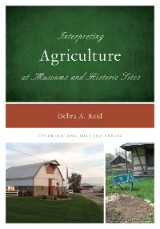Details

Interpreting Agriculture at Museums and Historic Sites
Interpreting History, Band 12
|
44,99 € |
|
| Verlag: | Rowman & Littlefield Publishers |
| Format: | EPUB |
| Veröffentl.: | 23.01.2017 |
| ISBN/EAN: | 9781442230125 |
| Sprache: | englisch |
| Anzahl Seiten: | 284 |
DRM-geschütztes eBook, Sie benötigen z.B. Adobe Digital Editions und eine Adobe ID zum Lesen.
Beschreibungen
<span><span>Interpreting Agriculture in Museums and Historic Sites</span><span> orients readers to major themes in agriculture and techniques in education and interpretation that can help you develop humanities-based public programming that enhance agricultural literacy. Case studies illustrate the ways that local research can help you link your history organization to compelling local, national (even international) stories focused on the multidisciplinary topic. That ordinary plow, pitch fork, and butter paddle can provide the tangible evidence of the story worth telling, even if the farm land has disappeared into subdivisions and agriculture seems as remote as the nineteenth century. Other topics include discussion of alliances between rural tourism and community-supported agriculture, farmland conservation and stewardship, heritage breed and seed preservation efforts, and antique tractor clubs. Any of these can become indispensable partners to history organizations searching for a new interpretive theme to explore and new partners to engage.</span></span>
<span><span>Why should our museum accept and exhibit that tractor? Why do we need to keep those old seed samples or those plows? No one cares about farming anymore. </span><span>Interpreting Agriculture in Museums and Historic Sites</span><span> orients readers to major themes in agriculture and techniques in education and interpretation that can help you develop humanities-based public programming that enhance agricultural literacy</span><span>. </span><span>Case studies illustrate the ways that local research can help you link your history organization to compelling national (even international) stories on topics relevant to public needs and interests.</span></span>
<span><span>Foreword – Tom Kelleher</span></span>
<br>
<span><span>Part 1: Developing Interpretation with an Agricultural Perspective</span></span>
<br>
<span><span>Chapter 1 Interpreting Agriculture: Introduction to Terms and Themes</span></span>
<br>
<span><span>Chapter 2 Once a Field, now Suburbia: Interpreting Agriculture in Any Context</span></span>
<br>
<span><span>Chapter 3 Agriculture: Developing a Humanist Point of View</span></span>
<br>
<span><span>Chapter 4 Agriculture and Historical Thinking</span></span>
<br>
<span><span>Part 2: Agriculture in Time and Place: Research as the Foundation for Interpretation</span></span>
<br>
<span><span>Chapter 5 Documenting Agriculture in Two Dimensions: Background Research</span></span>
<br>
<span><span>Chapter 6 Documenting Agriculture in Three Dimensions: Artifacts</span></span>
<br>
<span><span>Research Summaries:</span></span>
<br>
<span><span>Chapter 7 You Can’t Eat Gold: Agriculture in Early Colorado City, 1858-1867, Carol Kennis Lopez</span></span>
<br>
<span><span>Chapter 8 Changes in Corn-Belt Crop Culture: Iowa, 1945-1972, J.L. Anderson</span></span>
<br>
<span><span>Chapter 9 A Curator’s Legacy, William S. Pretzer</span></span>
<br>
<span><span>Part 3: Thematic Studies to Inform Localized Agriculture Interpretation</span></span>
<br>
<span><span>Chapter 10 Roads and Bridges in Rural Agricultural Interpretation, Cameron L. Saffell and Debra A. Reid</span></span>
<br>
<span><span>Chapter 11 Horses, Harness, and Transport: Informing Interdisciplinary Interpretation, Barbara Corson, VMD </span></span>
<br>
<span><span>Chapter 12 Livestock in Agricultural Interpretation, Jonathan D. Kuester and Debra Reid</span></span>
<br>
<span><span>Chapter 13 Sex, Drugs, and GMOs: Crops and Agricultural Interpretation</span></span>
<br>
<span><span>Part 4: Developing Interpretation</span></span>
<br>
<span><span>Chapter 14 Interpreting Agriculture: A Multi-Step Sequential Process</span></span>
<br>
<span><span>Chapter 15 Case Study – Interpreting Rural Life in El Paso, Texas, Cameron L. Saffell</span></span>
<br>
<span><span>Chapter 16 Case Study: An Exhibit – Reaper: Nettie Fowler McCormick and the Machine that Built Tusculum College, Peter M. Noll</span></span>
<br>
<span><span>Conclusion</span></span>
<br>
<span><span>Appendix: Links to Useful Information</span></span>
<br>
<span><span>Part 1: Developing Interpretation with an Agricultural Perspective</span></span>
<br>
<span><span>Chapter 1 Interpreting Agriculture: Introduction to Terms and Themes</span></span>
<br>
<span><span>Chapter 2 Once a Field, now Suburbia: Interpreting Agriculture in Any Context</span></span>
<br>
<span><span>Chapter 3 Agriculture: Developing a Humanist Point of View</span></span>
<br>
<span><span>Chapter 4 Agriculture and Historical Thinking</span></span>
<br>
<span><span>Part 2: Agriculture in Time and Place: Research as the Foundation for Interpretation</span></span>
<br>
<span><span>Chapter 5 Documenting Agriculture in Two Dimensions: Background Research</span></span>
<br>
<span><span>Chapter 6 Documenting Agriculture in Three Dimensions: Artifacts</span></span>
<br>
<span><span>Research Summaries:</span></span>
<br>
<span><span>Chapter 7 You Can’t Eat Gold: Agriculture in Early Colorado City, 1858-1867, Carol Kennis Lopez</span></span>
<br>
<span><span>Chapter 8 Changes in Corn-Belt Crop Culture: Iowa, 1945-1972, J.L. Anderson</span></span>
<br>
<span><span>Chapter 9 A Curator’s Legacy, William S. Pretzer</span></span>
<br>
<span><span>Part 3: Thematic Studies to Inform Localized Agriculture Interpretation</span></span>
<br>
<span><span>Chapter 10 Roads and Bridges in Rural Agricultural Interpretation, Cameron L. Saffell and Debra A. Reid</span></span>
<br>
<span><span>Chapter 11 Horses, Harness, and Transport: Informing Interdisciplinary Interpretation, Barbara Corson, VMD </span></span>
<br>
<span><span>Chapter 12 Livestock in Agricultural Interpretation, Jonathan D. Kuester and Debra Reid</span></span>
<br>
<span><span>Chapter 13 Sex, Drugs, and GMOs: Crops and Agricultural Interpretation</span></span>
<br>
<span><span>Part 4: Developing Interpretation</span></span>
<br>
<span><span>Chapter 14 Interpreting Agriculture: A Multi-Step Sequential Process</span></span>
<br>
<span><span>Chapter 15 Case Study – Interpreting Rural Life in El Paso, Texas, Cameron L. Saffell</span></span>
<br>
<span><span>Chapter 16 Case Study: An Exhibit – Reaper: Nettie Fowler McCormick and the Machine that Built Tusculum College, Peter M. Noll</span></span>
<br>
<span><span>Conclusion</span></span>
<br>
<span><span>Appendix: Links to Useful Information</span></span>
<span><span>Debra A. Reid</span><span> is curator of agriculture and the environment at The Henry Ford, and professor emeritus in the Department of History and Historical Administration Graduate Program at Eastern Illinois University. Since 2006 she has also served as adjunct professor at the University of Illinois in the College of Agricultural, Consumer and Environmental Sciences.</span></span>
<br>
<span><span><br><br></span></span>
<br>
<span><span><br><br></span></span>
Diese Produkte könnten Sie auch interessieren:

A Sea Change: The Exclusive Economic Zone and Governance Institutions for Living Marine Resources

von: Syma A. Ebbin, Alf H. Hoel, Are Sydnes

96,29 €















